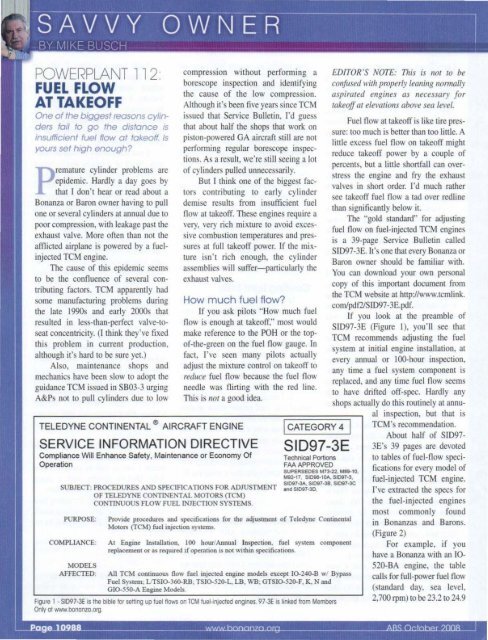AVIATOR pOinls - American Bonanza Society
AVIATOR pOinls - American Bonanza Society
AVIATOR pOinls - American Bonanza Society
Create successful ePaper yourself
Turn your PDF publications into a flip-book with our unique Google optimized e-Paper software.
POWERPLANT 112:<br />
FUEL FLOW<br />
AT TAKEOFF<br />
One of the biggest reosons cylinders<br />
fail to go the distance is<br />
insufficient fuel flow at takeoff. Is<br />
yours set high enough<br />
Premature cylinder problems are<br />
epidemic. Hardly a day goes by<br />
that I don't hear or read about a<br />
<strong>Bonanza</strong> or Baron owner having to pull<br />
one or several cylinders at annual due to<br />
poor compression, with leakage past the<br />
exhaust valve. More often than not the<br />
afflicted airplane is powered by a fuelinjected<br />
TCM engine.<br />
The cause of this epidemic seems<br />
to be the confluence of several contributing<br />
factors. TCM apparently had<br />
some manufacturing problems during<br />
the late 1990s and early 2000s that<br />
resulted in less-than-perfect valve-toseat<br />
concentricity. (I think they 've fixed<br />
this problem in current production,<br />
although it's hard to be sure yet.)<br />
Also, maintenance shops and<br />
mechanics have been slow to adopt the<br />
guidance TCM issued in SB03-3 urging<br />
A&Ps not to pull cylinders due 10 low<br />
TELEDYNE CONTINENTAL ® AIRCRAFT ENGINE<br />
compression without performing a<br />
borescope inspection and identifying<br />
the cause of the low compression.<br />
Although it's been five years since TCM<br />
issued that Service Bulletin. I'd guess<br />
that about half the shops that work on<br />
piston-powered GA aircraft still are not<br />
performing regular borescope inspections.<br />
As a result, we're still seeing a lot<br />
of cylinders pulled unnecessarily.<br />
But I think one of the biggest factors<br />
contributing to early cylinder<br />
demise results from insufficient fuel<br />
flow at takeoff. These engines require a<br />
very, very rich mixture to avoid excessive<br />
combustion temperatures and pressures<br />
at full takeoff power. [f the mixture<br />
isn't rich enough, the cylinder<br />
assemblies will suffer- panicularly the<br />
exhaust valves.<br />
How much fuel flow<br />
If you ask pi lots "How much fuel<br />
flow is enough at takeoff," most would<br />
make reference to the POH or the topof-the-green<br />
on the fuel flow gauge. In<br />
fact, I've seen many pilots actually<br />
adjust the mixture control on takeoff to<br />
reduce fuel flow because the fuel flow<br />
needle was flirting with the red line.<br />
This is /lot a good idea.<br />
SERVICE INFORMATION DIRECTIVE<br />
Compliance Will Enhance Safety, Maintenance or Economy Of<br />
Operation<br />
SUBJECT: PROCEDURES AND SPECIFICATIONS FOR ADJUSTMENT<br />
OF TELEDYNE CONTINENTAL MOTORS (rCM)<br />
CONTINUOUS FLOW FtJEL INJECTION SYSTEMS.<br />
PURPOSE:<br />
I CATEGORY 4 I<br />
SID97-3E<br />
Technical Portions<br />
FAA APPROVED<br />
SUPERSEDES M73-22, M8~-10 .<br />
M92·17. 51098-10A,51097-3,<br />
SI[)g7·3A, 51097·38, SIOg7.JC<br />
and 51097·30,<br />
Provide procedures and specifications for the adjustment of Teledyne Continental<br />
Motors (reM) fuel injeclion systems.<br />
COMPLIANCE: At Engine Installalion. 100 hour/Annual Inspection. fuel system component<br />
replacement or as required if operation is not within specificalions.<br />
MODELS<br />
AFFECTED:<br />
All TCM continuous flow fuel injected engine models except 10-240-8 wI Bypass<br />
Fuel System: urSIO-360-RB: TSIO-520-L, LB, WB: GTSIO-520,F, K, N and<br />
GIO-550-A Engine Models.<br />
Figure 1 - SID97-3E is the bible for setting up fuel News on reM fuel-injected engines. 97·3E is linked from Members<br />
Only 01 W'IM.bonanzo.org.<br />
EDITOR'S NOTE: This is /lot to be<br />
eOllfused with properly lea/li/lg /lormally<br />
aspirated engilles as /leeessary for<br />
takeoff at elevatiollS above sea level.<br />
Fuel flow at takeoff is like tire pressure:<br />
too much is better than too little. A<br />
little excess fuel flow on takeoff might<br />
reduce takeoff power by a couple of<br />
percents, but a little shonfaLl can overstress<br />
the engine and fry the exhaust<br />
valves in shon order. I'd much rather<br />
see takeoff fuel flow a tad over redline<br />
than significantly below it.<br />
The "gold standard" for adjusting<br />
fue l flow on fuel-injected TCM engines<br />
is a 39-page Service Bulletin called<br />
SlD97-3E. It's one that every <strong>Bonanza</strong> or<br />
Baron owner should be familiar with.<br />
You can download your own personal<br />
copy of this irnp0l1ant document from<br />
the TCM website at hnp:llwww.tcmlink.<br />
com/pdf2/SlD97-3E.pdf.<br />
[f you look at the preamble of<br />
SlD97-3E (Figure I), you'll see that<br />
TCM recommends adjusting the fuel<br />
system at initial engine installation, at<br />
every annual or lOO-hour inspection,<br />
any time a fuel system component is<br />
replaced, and any time fuel flow seems<br />
to have drifted off-spec. Hardly any<br />
shops actually do this routinely at annual<br />
inspection , but that is<br />
TCM's recommendation.<br />
About half of SlD97-<br />
3E's 39 pages are devoted<br />
to tables of fuel-flow specifications<br />
for every model of<br />
fuel-injected TCM engine.<br />
I've extracted the specs for<br />
the fuel-injected engines<br />
most commonly found<br />
in <strong>Bonanza</strong>s and Barons.<br />
(Figure 2)<br />
For example, if you<br />
have a <strong>Bonanza</strong> with an [0-<br />
S20-BA engine, the table<br />
calls for full-power fuel flow<br />
(standard day, sea level ,<br />
2,700 rpm) to be 23.2 to 24.9

















